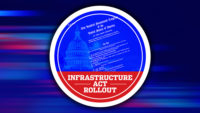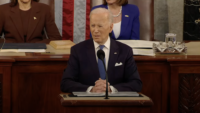It’s been one year since President Joe Biden signed the record-breaking $1.2-trillion Infrastructure Investment and Jobs Act in a ceremony on the South Lawn of the White House. Since then, his administration reports, federal agencies have announced distribution or award of more than $185 billion in funds for about 6,900 individual projects.
The U.S. Dept. of Transportation's Federal Highway Administration has the lion's share of the IIJA funding, with about $350 billion over five years, with highway funds the largest component of the DOT total.
FHWA Formula Funds
Industry officials say that since the IIJA was enacted on Nov. 15, 2021, FHWA has moved particularly quickly in distributing $120 billion in road and bridge funds apportioned to the states by formulas. Formula funds account for the vast majority of FHWA's total IIJA dollars.
Dave Bauer, American Road & Transportation Builders Association (ARTBA) president and chief executive officer, said in an interview,“The formula money has worked really well.” He adds, “They got that money out. They made it available and we’re already seeing really tangible impacts and benefits in every community from those formula dollars.”
ARTBA, citing data through Aug. 31 from the Treasury Dept., says that state DOTs have used IIJA formula highway funds for about 25,000 highway and bridge projects.
Emily Feenstra, American Society of Civil Engineers (ASCE) chief policy and external affairs officer, notes that with the formula funds, state and local agencies "have a clear understanding about how much they will be receiving and when they can expect it."
And those formula funds are leading to more construction.
Jay Hansen, National Asphalt Pavement Association (NAPA) executive vice president for advocacy, says, "The increased investment levels have been effectively distributed and state agencies are applying those funds to projects."
Hansen said in emailed comments, "We saw an uptick in project delivery this year. Backlogs are growing for many construction firms and next year we will see a lot of these projects under construction and completed."
DOT Competitive Grants
Other U.S. DOT infrastructure act funds have gone to increase existing competitive grant programs. For example, on Aug. 11, DOT announced the award of $2.2 billion in the RAISE grants.
RAISE, originally named TIGER, was launched in 2009. But the program received a $1.2-billion infusion from the IIJA.
DOT also has opened competitions for grants in new programs created by the infrastructure law, such as what DOT is calling the "Mega" program. Formally the National Infrastructure Project Assistance program, Mega is aimed at projects with national or regional significance and is funded at $5 billion over five years.
But because the department has had to develop new grant programs like Mega from scratch, the competitions and awards, as expected, are taking longer than with RAISE.
Applications closed in May, but DOT has yet to announce the Mega winners.
Michele Stanley, National Stone, Sand & Gravel Association (NSSGA) vice president of government and regulatory affairs, says that U.S. DOT has been distributing formula funds and issuing notices opening the competitions for grant programs “at an expedited pace."
But Stanley adds, "Where we are really seeing a slowdown and increase [in] complications is with the policy implementation. That includes rulemaking and guidance to states, or the lack thereof."
'Buy America' Flap
In particular, she and other industry officials point to the law's expanded Buy America provision for materials used in IIJA-funded projects. The law seeks to increase the use of U.S.-produced "iron, steel, manufactured products and construction materials" in federally funded projects.
The Associated Builders and Contractors has "serious concerns" about IIJA Buy America provisions, says Ben Brubeck, vice president of regulatory, labor and state affairs.
The IIJA excludes certain items from the definition of construction materials, including “cement and cementitious materials, aggregates such as stone, sand or gravel, or aggregate binding agents or additives," including asphalt binder.
Some groups sought a temporary waiver of the Buy American provision. And FHWA on May 19 granted such a waiver, lasting 180 days. It extended to Nov. 10.
With that deadline near, FHWA on Nov. 7 proposed to end the temporary, 180-day Buy America waiver for construction materials.
But the agency also proposed to add two more narrowly targeted waivers. One would deal with "de minimis costs, small grants and minor components."
The other waiver would apply to contracts entered into before March 10, 2023, that result from solicitations published before May 14, 2022.
NSSGA's Stanley said in emailed comments that her association helped to get stone, sand and gravel and other products excluded from the Buy America requirements.
But she says, "The administration hasn't put out meaningful guidance on this yet. And there's a lot of confusion at the state level, leading to each state doing its own thing, which is causing even more confusion."
NAPA's Hansen agrees, and says there are inconsistencies in implementing the requirement even as it applies to asphalt and concrete, "which were clearly exempted in IIJA."
He adds, "DOT needs to issue clear, cogent guidelines on Buy America because without it, project delivery will slow, putting at risk the gains made by IIJA in rebuilding our infrastructure."
Brubeck said in emailed comments that ABC supports efforts to increase U.S. jobs and manufacturing, but he adds that the group "is concerned that these requirements may lead to increased costs and delays of taxpayer-funded infrastructure."
He says Buy America impacts could worsen pressures on construction companies that face other issues, including supply-chain problems and inflation. Brubeck notes that nonresidential construction materials costs have jumped 41% since February 2020.
Buy America is not the only policy provision that industry has questions about. ARTBA's Bauer says IIJA provisions aimed at speeding federal reviews of infrastructure projects, have "not taken hold" yet.
They include codifying a Trump administration directive requiring "One Federal Decision" on such reviews.
Bauer says, "We're a year in and we have not seen the project delivery reforms' benefits utilized that were made available by the law."
The American Council of Engineering Cos. said in a statement, "Adequate funding is essential, but timely delivery of infrastructure to meet the challenges of climate mitigation, adaptation and resilience depends on efficient regulatory review."
EPA, GSA, Corps of Engineers
Among non-transportation agencies, the Environmental Protection Agency received $60 billion from the infrastructure law for drinking water and wastewater treatment, environmental cleanup and other programs.
That includes $14.1 billion for fiscal year 2022, of which the agency says it has awarded $5.5 billion. The largest portion of that is $4 billion awarded for water infrastructure state revolving funds. That SRF money is apportioned by formula, as with the FHWA formula funds.
ASCE's Feenstra cites EPA's IIJA Superfund program as one that has been working well. She says the program's IIJA funding allocations were among the earliest to be announced and has helped reduce the backlog of cleanup projects.
Feenstra says, "This program is exactly why it was so important that the [law] address all infrastructure categories, even those that we don't see on our daily commutes or when we turn on water from the tap."
The General Services Administration received $3.4 billion in IIJA funds to construct and upgrade land ports of entry—border stations—at 26 locations
So far GSA says it has obligated about $130 million for those projects.
The Army Corps of Engineers has announced $3.9 billion for 16 harbor and waterway projects, the White House says.
Looking Ahead
Brian Turmail, Associated General Contractors of America vice president for public affairs and strategic initiatives, says, "While we remain concerned with the administration's current approach to clarifying some of the regulatory details—including Buy America—associated with the [IIJA], a year later we are even more convinced the right thing to do was support the measure."
Turmail said via email that the law "is providing a needed boost to infrastructure spending and will do much to support the industry should today's current economic headwinds lead to a future downturn in private-sector demand for construction."
ARTBA's Bauer underscores that the IIJA is a five-year law and "we're just at the beginning."
Bauer says, "There are going to be five years' worth of money and five years' worth of benefits and it was not all going to accrue in Year One."
He adds, "We're seeing an impact and I think we're going to see more of an impact next year and even more in the years ahead."






Post a comment to this article
Report Abusive Comment